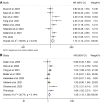Splenic volume as a predictor of survival in cancer patients treated with immune checkpoint inhibitors
- PMID: 40519921
- PMCID: PMC12163055
- DOI: 10.3389/fimmu.2025.1598484
Splenic volume as a predictor of survival in cancer patients treated with immune checkpoint inhibitors
Abstract
Objective: This investigation seeks to examine the association between spleen volume and prognosis in cancer patients undergoing immune checkpoint inhibitor (ICI) treatment.
Methods: We performed a retrospective analysis involving 61 patients diagnosed with hepatocellular carcinoma (HCC) who received ICIs at our institution. We evaluated the relationship between baseline splenic volume and its changes during ICI therapy concerning overall survival (OS) and progression-free survival (PFS) using a log-rank test. To identify relevant literature, we searched databases such as PubMed, EMBASE, the Cochrane Library, and Google Scholar up until February 20, 2024. The primary metrics assessed were hazard ratios (HR) for both OS and PFS, with pooled estimates and corresponding 95% confidence intervals (CIs) calculated.
Results: Within our study population, findings demonstrated a significantly decreased OS (HR: 2.02, 95% CI: 1.08-3.77, p = 0.027) and PFS (HR: 1.84, 95% CI: 1.05-3.21, p = 0.032) in HCC patients with a high baseline spleen volume, compared to individuals with lower spleen volumes. Additionally, HCC patients who experienced an increase in spleen volume during ICI therapy exhibited significantly poorer OS (HR: 2.27, 95% CI: 1.17-4.41, p = 0.016) and PFS (HR: 2.40, 95% CI: 1.30-4.41, p = 0.005) than those whose spleen volume decreased. The meta-analysis results revealed that subjects with higher spleen volumes had a significantly reduced OS (HR: 1.74, 95% CI: 1.12-2.72, p = 0.014) and PFS (HR: 1.35, 95% CI: 1.15-1.58, p < 0.001) compared to counterparts with lower volumes. Furthermore, the data clearly highlighted that patients with increases in splenic volume faced significantly poorer clinical outcomes, as indicated by reduced OS (HR: 1.83, 95% CI: 1.36-2.46, p < 0.001) and PFS (HR: 1.70, 95% CI: 1.28-2.25, p < 0.001) relative to those with decreases in splenic size.
Conclusion: A higher baseline spleen volume and an increase in spleen volume during ICI therapy were predictors of a poor prognosis in cancer patients treated with ICI.
Keywords: cancer; hepatocellular carcinoma; immune checkpoint inhibitors; prognosis; splenic volume.
Copyright © 2025 Zhang, Fu, Zhang, Zhou and Wang.
Conflict of interest statement
The authors declare that the research was conducted in the absence of any commercial or financial relationships that could be construed as a potential conflict of interest.
Figures






Similar articles
-
The load of hepatitis B virus reduces the immune checkpoint inhibitors efficiency in hepatocellular carcinoma patients.Front Immunol. 2024 Nov 27;15:1480520. doi: 10.3389/fimmu.2024.1480520. eCollection 2024. Front Immunol. 2024. PMID: 39664382 Free PMC article.
-
Potential predictors for survival in hepatocellular carcinoma patients treated with immune checkpoint inhibitors: A meta-analysis.Int Immunopharmacol. 2021 Nov;100:108135. doi: 10.1016/j.intimp.2021.108135. Epub 2021 Sep 13. Int Immunopharmacol. 2021. PMID: 34530205 Review.
-
Comparative efficacy and safety of transarterial chemoembolization combined with tyrosine kinase inhibitors and immune checkpoint inhibitors versus tyrosine kinase inhibitors and immune checkpoint inhibitors alone in advanced hepatocellular carcinoma: a systematic review and meta-analysis.World J Surg Oncol. 2025 Apr 7;23(1):126. doi: 10.1186/s12957-025-03788-0. World J Surg Oncol. 2025. PMID: 40197348 Free PMC article.
-
The pattern of tumor progression on first-line immune checkpoint inhibitor-based systemic therapy for Chinese advanced hepatocellular carcinoma -CLEAP 004 study.Front Immunol. 2024 Apr 22;15:1310239. doi: 10.3389/fimmu.2024.1310239. eCollection 2024. Front Immunol. 2024. PMID: 38711515 Free PMC article.
-
Prognostic value of platelet-to-lymphocyte ratio in hepatocellular carcinoma patients treated with immune checkpoint inhibitors: a systematic review and meta-analysis.BMC Gastroenterol. 2025 Jun 6;25(1):437. doi: 10.1186/s12876-025-04028-1. BMC Gastroenterol. 2025. PMID: 40481391 Free PMC article.
References
-
- Yuan Q, Deng D, Pan C, Ren J, Wei T, Wu Z, et al. Integration of transcriptomics, proteomics, and metabolomics data to reveal HER2-associated metabolic heterogeneity in gastric cancer with response to immunotherapy and neoadjuvant chemotherapy. Front Immunol. (2022) 13:951137. doi: 10.3389/fimmu.2022.951137 - DOI - PMC - PubMed
MeSH terms
Substances
LinkOut - more resources
Full Text Sources
Medical

